Oystercatcher Summer 2023

NOAA Assistant Administrator Nicole LeBoeuf Visits the Apalachicola National Estuarine Research Reserve
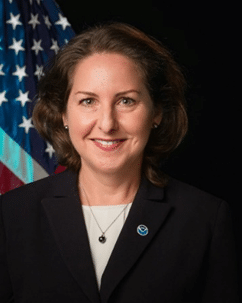
Nicole LeBoeuf, Assistant Administrator for NOAA's National Ocean Service, visited the Apalachicola National Estuarine Research Reserve (ANERR) on May 26. During the visit, LeBoeuf toured the reserve’s Nature Center and met with staff and partners to discuss the reserve's work. Alex Reed, Director of DEP’s, and ANERR Manager Jenna Harper were both present during the visit.
LeBoeuf toured the facility and the living shoreline at Millender Park, where LeBoeuf met with reserve partners Evan Blythe from the Apalachee Regional Planning Council; Holden Foley, Restoration Director from the Conservation Corps of the Forgotten Coast; Jon Brucker, DEP aquatic preserve manager; and Environmental Manager Kim Miller from DEP. Following the tour, LeBeouf also met with Franklin County Commissioner Ottice Amison and Dr. Joel Trexler and Dr. Sandra Brooke with the Apalachicola Bay System Initiative to discuss the status of the oyster population and restoration efforts, as well as the reserve's collaboration with other community partners.

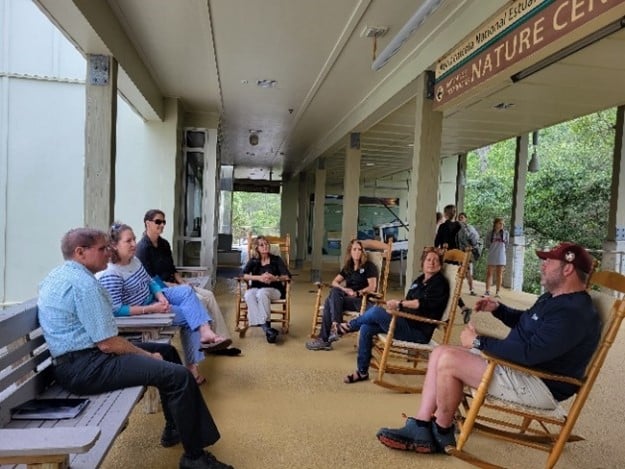
Stewardship Completes Beach and Marsh Monitoring via Unmanned Aircraft System (UAS) and Light Detection and Ranging (LiDAR) Surveys with Collaborators
Summer research activities are fully underway. One of the top priorities for the 2023 season was to fill our open research position, and in June we were excited to welcome Kendra Treichel to our team. Kendra’s main responsibilities are to maintain the reserve’s climate and sea level data collection infrastructure, which consists of marsh surface elevation monitoring tables, marsh vegetation transects, and marsh sediment pore water wells.
In addition to hiring our new teammate, ANERR was successful in the acquisition of $35,000 in state funding for the purchase of additional marsh monitoring equipment. The reserve was able to acquire 20 new pore water level and salinity loggers. We were also successful in acquiring additional funds to conduct geodetic leveling of all our infrastructure, including our System-Wide Monitoring Program (SWMP) water quality towers, which will allow us to continue to maintain the sites as actual tie stations.
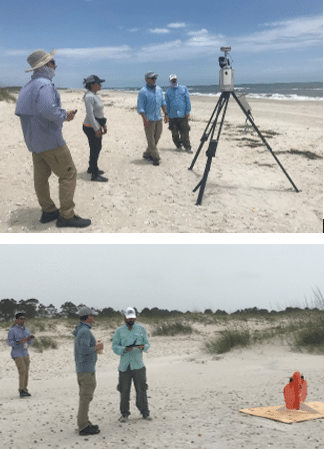
Summer Stewardship Intern Joins the Team

ANERR’s summer stewardship intern, Wallace Walker, joined our team last month! Wallace is quickly taking to the work and is eager to learn more about the local flora and fauna of the gulf! Being born and raised in Melbourne, Florida, they grew up participating in beach and wetland cleanups. Wallace attended school at Iowa State University to study Forestry and Entomology.
Spurred by a passion in watershed management, Wallace moved to Washington state to lead an AmeriCorps crew in watershed and trail restoration. During this time, they were able to work in the San Juan Islands (Washington), helping remove creosote logs from the coastlines. This sparked an interest in islands, which led them to the Palmyra Atoll. Living in a small remote community Wallace worked as a rainforest realignment intern with the U.S. Fish and Wildlife Service, monitoring the seabird populations and managing the coconut palm population.
Missing the luxuries of civilization and their Washington community, Wallace took a position in Portland to work in the at a native nursery that focuses on wetland restoration. Later they joined the San Clemente Island Natural Resource team as a seasonal botanist, working on monitoring and protecting the island’s endemic plants located around the Naval Auxiliary Landing Field. With a deep passion for coastal restoration and a love for remote island ecosystems, Wallace is thrilled to be working on Little St. George Island this year!
Research Upgrades Climate and Sea Level Monitoring Program Equipment
Summer research activities are fully underway. One of the top priorities for the 2023 season was to fill our open research position, and in June we were excited to welcome Kendra Treichel to our team. Kendra’s main responsibilities are to maintain the reserve’s climate and sea level data collection infrastructure, which consists of marsh surface elevation monitoring tables, marsh vegetation transects, and marsh sediment pore water wells.
In addition to hiring our new teammate, ANERR was successful in the acquisition of $35,000 in state funding for the purchase of additional marsh monitoring equipment. The reserve was able to acquire 20 new pore water level and salinity loggers. We were also successful in acquiring additional funds to conduct geodetic leveling of all our infrastructure, including our System-Wide Monitoring Program (SWMP) water quality towers, which will allow us to continue to maintain the sites as actual tie stations.
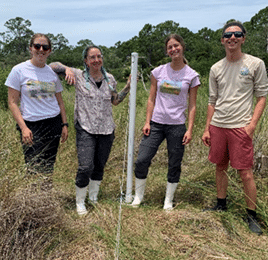
Summer Research with Our Margaret A. Davidson Fellow
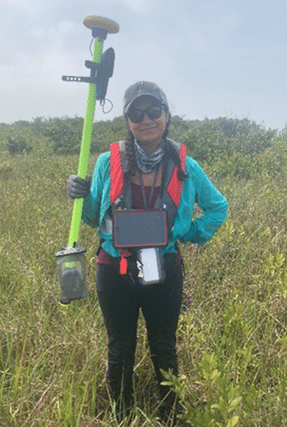
Research staff have had the opportunity to collaborate with ANERR’s second cohort of the Margaret A. Davidson Fellowship, Jen Bueno. Jen is a Ph.D. student at Florida State University working through her dissertation entitled, “Using high resolution aerial imagery to quantify rates of mangrove encroachment into estuarine habitats in Apalachicola Bay.” Jen has been spending field time working with our research and stewardship staff by using drones to map mangroves in the marshes.
We are having such a great time working with Jen that it is hard to believe that we are already halfway through the current fellowship, which means that it is time to begin searching for a third fellowship candidate. The two-year fellowship program provides the opportunity for graduate students to conduct collaborative research at one of the 30 national estuarine research reserves, and in June 2023, the Apalachicola reserve began active recruitment for our 2024 fellowship applicants. The fellowship allows students to address key reserve management needs to help scientists and communities understand coastal challenges that may influence future policy and management strategies.
The request for proposals is available on the Grants.gov website and anyone interested in the fellowship can email ANERR Research Coordinator Jason Garwood for information. Completed applications are due Dec. 4, 2023.
Workshop: Coastal Training Program Collaborates with the Florida Coastal Management Program to Discuss Grants
The Coastal Training Program (CTP) staff in collaboration with the DEP’s Florida Coastal Management Program (FCMP) office hosted a workshop at the Apalachicola reserve on June 15 focused on Coastal Partnership Initiative grants.
The FCMP staff presented detailed information about the grant program and discussed its objectives, eligibility criteria and application process. Additionally, the staff went over the deadlines to submit grant applications, ensuring that attendees were well-informed about the timeline.
FCMP staff also shared information about the Bipartisan Infrastructure Funding that has recently been released. This additional information was likely relevant to the workshop attendees, providing them with an understanding of the broader funding opportunities available for coastal management and infrastructure projects.
The workshop participants represented a wide range of stakeholders. County and city leaders, planning and grant staff, representatives from estuary programs, Conservation Corps administrators, university staff, water management districts and engineering firms were present. The workshop provided valuable information and networking opportunities, fostering collaboration and partnerships in coastal management efforts in the Panhandle region.

Teachers On the Estuary
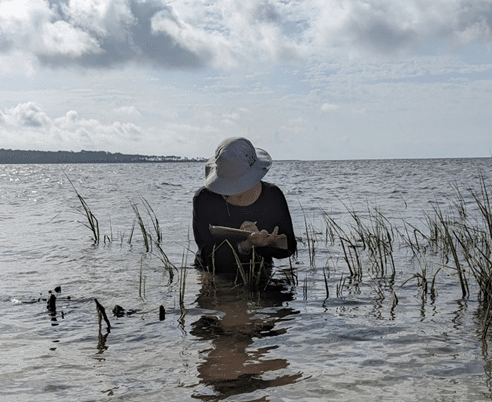
The Apalachicola NERR hosted a Teachers on the Estuary (TOTE) workshop at the FSU Coastal Marine Lab on June 14 and 15 with the assistance of staff from Rookery Bay National Estuarine Research Reserve. TOTE is a professional development workshop held yearly at each of the state’s three national estuarine research reserves. Thirteen teachers attended from across a variety of grade levels and disciplines. The focus for the two days was on using rigorous nature journaling techniques to show how language, math, civics, theater, and science content can all emerge from student observations and questions. Using the nature journal approach, the student’s own curiosity can steer follow-up investigations and experimentation. The teachers were unanimously appreciative of the workshop with 100% ranking, the highest marks on all criteria in the post-program evaluation.
Upcoming Events
Coastal Cleanup, Sept. 16
Reserve Wednesday, Sept. 20, Bat with Kim Chase
Sci-Cafe, Sept. 21, Early Inhabitants of the Apalachicola Valley with Nancy White
Oyster Ecology Class, Sept. 26
Apalachicola River & Floodplain Workshop, Oct. 6
Bay Friendly Landscaping Workshop, Oct. 10
Reserve Wednesday, Oct. 16, Monarch Butterflies with David Cook
Estuary Exploration Workshop, Oct. 20
Apalachicola River & Floodplain Workshop, Nov. 8
Flight of the Monarch Event, Nov. 9, 3-6pm
Oyster Ecology Class, Nov. 14
Reserve Wednesday, Nov 15, Coastal Soils with Josh Breithaupt
Sci-Cafe, Nov. 16,
Update on Apalachicola Bay Restoration Dr. Sandra Brooke and Devin Resko
Bay Friendly Landscaping Workshop, Nov. 21
Estuary Exploration Workshop, Nov. 30
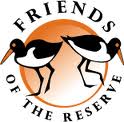
Join the Friends of the Reserve, a nonprofit organization providing support to the Apalachicola National Estuarine Research Reserve. Be a part of a group of people directly involved with the reserve's research, stewardship and education programs.
